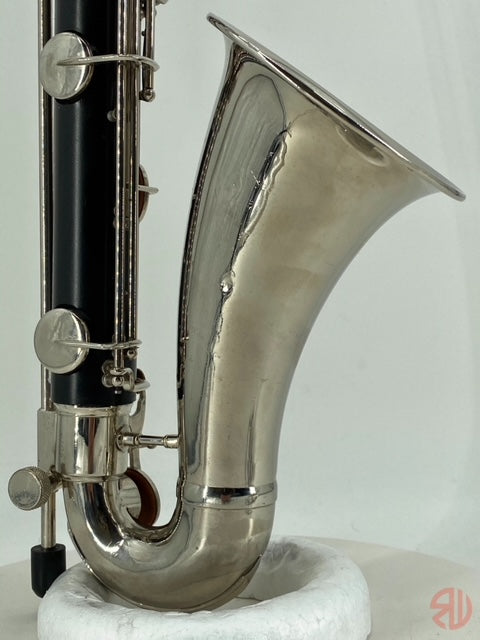

I've since "upgraded" to a brand new model 340 Leblanc contralike the one pictured above, with range to low C (sounding the lowest Bbon the piano). This instrumentis particularly interesting in that it comes apart: the loop section breaksdown in the middle, and the whole thing fits into a case about 27" long(about 70 cm). Lowest note is written D (sounding contra C). My first contrabass was a BBb Leblancthatwas made around 1950, overhauled and restored by CharlesFail Music. I carry the stands in a bag made for carryingmicrophone stands.

It really helps, althoughit is nearly five feet long - it is still lighter, and less awkward thantwo 4' contra cases.

The solution: have AltieriBags make a custom double contra gig bag. Recently I've been playing both Eb and Bb contra withthe San Jose Wind Symphony, along with (sometimes) Bb bass sarrusophone. Between the three cases, and the stands, and the music, it was gettinga little. The Eb contra is also popular because one can sight-transposebass clef music (read the bass clef music by pretending its treble, whileadjusting the key signature by removing 3 flats or adding 3 sharps or acombination). The Eb contrabass (also known as the "contra-alto" or"contralto") is also available in loop or straight forms, in metal or wood,from Selmer (Paris) (rosewood), Selmer/Bundy(resonite), Buffet Crampon(wood), Leblanc(metal),and Vito(resonite).It is pitched in between the Bb bass and the Bb contrabass instruments,with low range to Eb, D or C (concert Gb, F or Eb, an octave below thebass clef). You may still be able to findone at a music store. Unfortunately, it appears thatLeblanc has discontinued production. The standis adjustable, so that one can use it instead of the peg, and can evenplay the instrument while standing. Leblanc makes (or made) a sturdy stand specifically for thecoiled contras (adjustable for Bb or Eb instruments), which can be orderedfrom the Woodwind & Brasswind. The stand has a heavy (but collapsible) tripod base, with a detachablecradle that supports the bottom of the instrument, and a brace (with asnap-on leather strap) that supports the horn at one of the cross-braces. The first viewshows the stand alone, while the secondview shows the stand supporting a model 340 Bb contra. Less often, oneencounters them in orchestral music, pit orchestras, and the ocassionaljazz solo.īelieve it or not, there are stands for these instruments,too.

Modern Leblanc contras (model 340, picturedat right) and Selmer contrabasses have extended range to low C (the Leblanc342 has range to low Eb).īoth the Eb and the Bb contra are most commonly foundin bands and wind ensembles, and clarinet choirs. AllLeblanc contras have a bore diameter of 1.182", while the Selmer contrahas a bore of 1.333". Straight contras are currently manufactured by Selmer(rosewood), Leblanc(metal),and Vito(resonite).As far as I know, the looped contra is made only by Leblanc. One can find contrabasses in the loop shape shown here(often referred to as "curved", "looped", or "paperclip" form), or in the"straight" shape, which looks like a larger bass clarinet with a long neck.The looped contras are all metal, while the straight contras may be metalor wood (or resin). Older instruments will usually have a range extended downto low D or Eb. The contrabass clarinet is pitched in Bb, two octavesbelow the Bb soprano clarinet (one octave below the bass clarinet), witha range frequently extended downward to low D or C (the lowest Bb on thepiano).


 0 kommentar(er)
0 kommentar(er)
